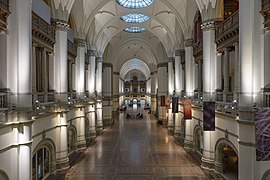Nordic Museum
You can help expand this article with text translated from the corresponding article in Swedish. (March 2024) Click [show] for important translation instructions.
|
Nordiska museet | |
Djurgården Line Ferry: Djurgården ferry | |
| Website | nordiskamuseet.se |
|---|---|


The Nordic Museum (
History
The museum was originally (1873) called the Scandinavian Ethnographic Collection (Skandinavisk-etnografiska samlingen), from 1880 the Nordic Museum (Nordiska Museum, now Nordiska museet). When Hazelius established the open-air museum Skansen in 1891, it was the second such museum in the world.
For the museum, Hazelius bought or got donations of objects like furniture, clothes and toys from all over Sweden and the other Nordic countries; he emphasised the peasant culture, but his successors increasingly started to collect objects reflecting bourgeois and urban lifestyles as well. For Skansen, he collected entire buildings and farms.
Although the project did not initially get the government funding he had hoped, Hazelius received widespread support and donations and by 1898, the Society for the promotion of the Nordic Museum (Samfundet för Nordiska Museets främjande) had 4,525 members. The Riksdag allocated some money for the museums in 1891 and doubled the amount in 1900, the year before Hazelius died.
Building

The present building, the design of
Collections
The museum has over 1.5 million objects in its collections, including buildings such as the Julita farm in
Gallery
Exterior
-
Sculpture on the western gable
-
Spire
-
Onion dome
-
Gilt scuppers
-
Street View
-
From south
Interior
-
Entrance hall with Gustav Vasa
-
Main hall
-
Roof lantern
-
Exhibition on the history of dining table arrangements
See also
References
- ^ "Besöksrekord på landets museer" (PDF). Riksförbundet Sveriges museer. Retrieved 22 November 2016.
- ISBN 91-86050-41-9.
- ^ "Collections". Nordiska museet. Retrieved 11 October 2014.
- ^ "Fotografiska samlingar". Nordiska museet. Retrieved 2016-11-22.
- ^ "Bibliotekets samlingar". Nordiska museet. Retrieved 2016-11-22.
External links
- Official website
- Nordic Museum within Google Arts & Culture
 Media related to Nordiska museet at Wikimedia Commons
Media related to Nordiska museet at Wikimedia Commons










